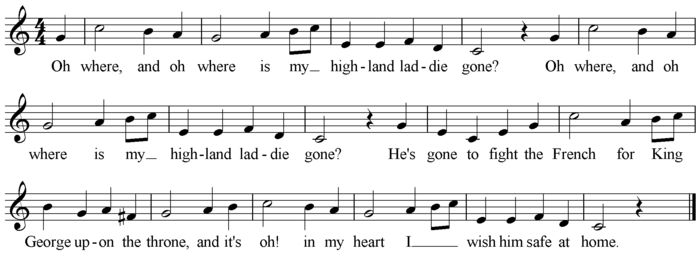Bluebells of Scotland
Blue Bells of Scotland is a traditional Scottish folk song (Roud # 13849). It was written by Dora Jordan an English actress and writer. First published in 1801.
Text
As with most folk songs, it exists in multiple versions. In the version printed in 1803 in the Scots Musical Museum, the words are:
- O where and O where does your highland laddie dwell;
- O where and O where does your highland laddie dwell;
- He dwells in merry Scotland where the blue bells sweetly smell,
- And all in my heart I love my laddie well'
A broadside ballad version from slightly later in the 19th century makes references to George III and the Napoleonic wars:
- Oh, where, and oh, where is my highland laddie gone,
- Oh, where, and oh, where is my highland laddie gone,
- He's gone to fight the French, for King George upon the throne,
- And it's oh in my heart I wish him safe at home[1]
The bluebell is a flower; see Common bluebell and Campanula rotundifolia.
Tune

Arrangements
Joseph Haydn wrote a piano trio accompaniment for this song (Hob. XXXIa: 176).
The song has been arranged by Arthur Pryor for trombone with potential orchestra accompaniment. Although the exact date is disputed due to some naming questions, Pryor probably composed the piece around 1899. The piece is technically challenging.
The piece allows the trombonist to show off a flowing legato while, in different places, requiring some difficult jumps and leaps. The sheer speed and volume of notes also poses a significant challenge. It is in theme and variation form, and opens a 24-bar intro. After the theme, it moves to the allegro section, in which the variations begin. Variation one involves triplets, while variation two involves syncopated sixteenth-eighth note rhythms. The cadenza that follows demonstrates the performer's range; jumping from a high C (an octave above the Middle C) to a low pedal G, for example. The vivace finale brings all these techniques into one, requiring the trombonist to exhibit advanced range, legato, double tonguing and flexibility. Thus, the piece is limited to the best trombonists, although there have been numerous recordings of the piece by such famed players as Joseph Alessi and Christian Lindberg.
Blue Bells of Scotland is often likened to be the trombone and euphonium equivalent (in terms of required mastery of the instrument) to the Carnival of Venice for trumpet and cornet by Jean-Baptiste Arban.
American composer Leroy Anderson also wrote an orchestral arrangement giving a very clean and sprightly melody to the high strings and woodwinds, befitting the female speaker of the lyrics.
 |
Blue Bells of Scotland, for Trombone and Band (As performed by Dennis Smith)
|
| Problems playing this file? See media help. | |
Notes
- ↑ Both versions taken from http://www.nls.uk/broadsides/broadside.cfm/id/20870.
Bibliography
- Herbert, Trevor and John Wallace, eds. (1997). The Cambridge Companion to Brass Instruments. Cambridge: Cambridge University Press.
- Less, Gene (2003). Friends Along the Way: A Journey Through Jazz. New Haven: Yale University Press.